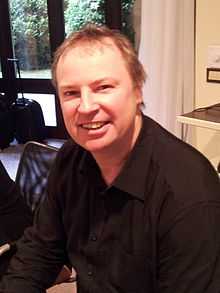Peer Bork
| Peer Bork | |
|---|---|
 | |
| Born |
4 May 1963 Berlin, Germany |
| Residence | Heidelberg, Germany |
| Citizenship | German |
| Nationality | German |
| Fields | Computational Biology |
| Institutions | EMBL, MDC |
| Notable awards |
|
Peer Bork is senior group leader and joint head of the Structural and Computational Biology unit at EMBL,[1] a European research organization with headquarters in Heidelberg where he also serves as strategic head of bioinformatics. In addition, he holds an appointment at the Max-Delbrueck-Center for Molecular Medicine in Berlin.[2] Dr. Bork received his PhD in Biochemistry (1990) and his Habilitation in Theoretical Biophysics (1995). He works in various areas of computational biology and systems analysis with a focus on function prediction, comparative analysis and data integration.
Dr. Peer Bork coauthored more than 500 research articles in international, peer-reviewed journals,[3] among them more than 50 in Nature, Science and Cell. According to ISI (analyzing 10 years spans), Dr. Bork was for many years the most cited European researcher in Molecular Biology and Genetics and is among the top 5 in Biochemistry and Biology. He is on the editorial board of a number of journals including Science and PLoS Biology, and functions as senior editor of the journal Molecular Systems Biology.[4] Dr. Bork co-founded five biotech companies, two of which went public. More than 35 of his former associates now hold professorships or other group leader positions in prominent institutions all over the world. He received the "Nature Award for Creative Mentoring"[5] for his achievements in nurturing and stimulating young scientists. He was also the recipient of the prestigious "Royal Society and Academie des Sciences Microsoft Award" for the advancement of science using computational methods and obtained a competitive "ERC advanced investigator grant".
Research
According to Google Scholar,[6] his most cited peer-reviewed papers are on human genome,[7] mouse genome,[8] yeast proteome,[9] and Simple Modular Architecture Research Tool (SMART).[10] He has published on the human gut microbiome defining basic enterotypes[11] and an interactive Tree of Life.[12]
See a full list of Peer Bork's publications on PubMed.[13]
References
- ↑ Bork's personal page at EMBL
- ↑ Bioinformatics department of the Max Delbrück Center for Molecular Medicine
- ↑ Publication list of Bork Group
- ↑ "Molecular Systems Biology"
- ↑ Nature Award for Creative Mentoring in Science
- ↑ ""Peer Bork" - Google Scholar". Retrieved 13 Nov 2014.
- ↑ Lander, E. S.; Linton, M.; Birren, B.; Nusbaum, C.; Zody, C.; Baldwin, J.; Devon, K.; Dewar, K.; Doyle, M.; Fitzhugh, W.; Funke, R.; Gage, D.; Harris, K.; Heaford, A.; Howland, J.; Kann, L.; Lehoczky, J.; Levine, R.; McEwan, P.; McKernan, K.; Meldrim, J.; Mesirov, J. P.; Miranda, C.; Morris, W.; Naylor, J.; Raymond, C.; Rosetti, M.; Santos, R.; Sheridan, A. et al. (Feb 2001). "Initial sequencing and analysis of the human genome". Nature 409 (6822): 860–921. doi:10.1038/35057062. ISSN 0028-0836. PMID 11237011.
- ↑ Chinwalla, A. T.; Waterston, L. L.; Lindblad-Toh, K. D.; Birney, G. A.; Rogers, L. A.; Abril, R. S.; Agarwal, T. A.; Agarwala, L. W.; Ainscough, E. R.; Alexandersson, J. D.; An, T. L.; Antonarakis, W. E.; Attwood, J. O.; Baertsch, M. N.; Bailey, K. H.; Barlow, C. S.; Beck, T. C.; Berry, B.; Birren, J.; Bloom, E.; Bork, R. H.; Botcherby, M. C.; Bray, R. K.; Brent, S. P.; Brown, P.; Brown, E.; Bult, B.; Burton, T.; Butler, D. G.; Campbell, J. (2002). "Initial sequencing and comparative analysis of the mouse genome". Nature 420 (6915): 520–562. doi:10.1038/nature01262. PMID 12466850.
- ↑ Gavin, A. C.; Bösche, M.; Krause, R.; Grandi, P.; Marzioch, M.; Bauer, A.; Schultz, J.; Rick, J. M.; Michon, A. M.; Cruciat, C. M.; Remor, M.; Höfert, C.; Schelder, M.; Brajenovic, M.; Ruffner, H.; Merino, A.; Klein, K.; Hudak, M.; Dickson, D.; Rudi, T.; Gnau, V.; Bauch, A.; Bastuck, S.; Huhse, B.; Leutwein, C.; Heurtier, M. A.; Copley, R. R.; Edelmann, A.; Querfurth, E.; Rybin, V. (2002). "Functional organization of the yeast proteome by systematic analysis of protein complexes". Nature 415 (6868): 141–147. doi:10.1038/415141a. PMID 11805826.
- ↑ Schultz, J.; Milpetz, F.; Bork, P.; Ponting, C. (1998). "SMART, a simple modular architecture research tool: Identification of signaling domains". Proceedings of the National Academy of Sciences of the United States of America 95 (11): 5857–5864. Bibcode:1998PNAS...95.5857S. doi:10.1073/pnas.95.11.5857. PMC 34487. PMID 9600884.
- ↑ Arumugam, M.; Raes, J.; Pelletier, E.; Le Paslier, D.; Yamada, T.; Mende, D. R.; Fernandes, G. R.; Tap, J.; Bruls, T.; Batto, J. M.; Bertalan, M.; Borruel, N.; Casellas, F.; Fernandez, L.; Gautier, L.; Hansen, T.; Hattori, M.; Hayashi, T.; Kleerebezem, M.; Kurokawa, K.; Leclerc, M.; Levenez, F.; Manichanh, C.; Nielsen, H. B. R.; Nielsen, T.; Pons, N.; Poulain, J.; Qin, J.; Sicheritz-Ponten, T.; Tims, S. (2011). "Enterotypes of the human gut microbiome". Nature 473 (7346): 174–180. doi:10.1038/nature09944. PMC 3728647. PMID 21508958.
- ↑ Letunic, I.; Bork, P. (2011). "Interactive Tree of Life v2: Online annotation and display of phylogenetic trees made easy". Nucleic Acids Research 39: W475–8. doi:10.1093/nar/gkr201. PMC 3125724. PMID 21470960.
- ↑ Peer Bork's publications on PubMed
External links
- Website of the Bork Group at the EMBL
|